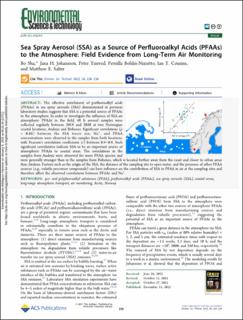| dc.contributor.author | Sha, Bo | |
| dc.contributor.author | Johansson, Jana H. | |
| dc.contributor.author | Tunved, Peter | |
| dc.contributor.author | Bohlin-Nizzetto, Pernilla | |
| dc.contributor.author | Cousins, Ian T. | |
| dc.contributor.author | Salter, Matthew E. | |
| dc.date.accessioned | 2022-01-18T11:26:59Z | |
| dc.date.available | 2022-01-18T11:26:59Z | |
| dc.date.created | 2022-01-06T10:20:39Z | |
| dc.date.issued | 2021 | |
| dc.identifier.citation | Environmental Science and Technology. 2021, 56, 228-238. | en_US |
| dc.identifier.issn | 0013-936X | |
| dc.identifier.uri | https://hdl.handle.net/11250/2837905 | |
| dc.description.abstract | The effective enrichment of perfluoroalkyl acids (PFAAs) in sea spray aerosols (SSA) demonstrated in previous laboratory studies suggests that SSA is a potential source of PFAAs to the atmosphere. In order to investigate the influence of SSA on atmospheric PFAAs in the field, 48 h aerosol samples were collected regularly between 2018 and 2020 at two Norwegian coastal locations, Andøya and Birkenes. Significant correlations (p < 0.05) between the SSA tracer ion, Na+, and PFAA concentrations were observed in the samples from both locations, with Pearson’s correlation coefficients (r) between 0.4–0.8. Such significant correlations indicate SSA to be an important source of atmospheric PFAAs to coastal areas. The correlations in the samples from Andøya were observed for more PFAA species and were generally stronger than in the samples from Birkenes, which is located further away from the coast and closer to urban areas than Andøya. Factors such as the origin of the SSA, the distance of the sampling site to open water, and the presence of other PFAA sources (e.g., volatile precursor compounds) can have influence on the contribution of SSA to PFAA in air at the sampling sites and therefore affect the observed correlations between PFAAs and Na+. | en_US |
| dc.language.iso | eng | en_US |
| dc.rights | Navngivelse 4.0 Internasjonal | * |
| dc.rights.uri | http://creativecommons.org/licenses/by/4.0/deed.no | * |
| dc.title | Sea Spray Aerosol (SSA) as a Source of Perfluoroalkyl Acids (PFAAs) to the Atmosphere: Field Evidence from Long-Term Air Monitoring | en_US |
| dc.type | Peer reviewed | en_US |
| dc.type | Journal article | en_US |
| dc.description.version | publishedVersion | en_US |
| dc.rights.holder | © 2021 The Authors. Published byAmerican Chemical Society. | en_US |
| dc.source.pagenumber | 228-238 | en_US |
| dc.source.volume | 56 | en_US |
| dc.source.journal | Environmental Science and Technology | en_US |
| dc.identifier.doi | 10.1021/acs.est.1c04277 | |
| dc.identifier.cristin | 1975679 | |
| dc.relation.project | NILU - Norsk institutt for luftforskning: 110035 | en_US |
| cristin.ispublished | true | |
| cristin.fulltext | original | |
| cristin.qualitycode | 2 | |

